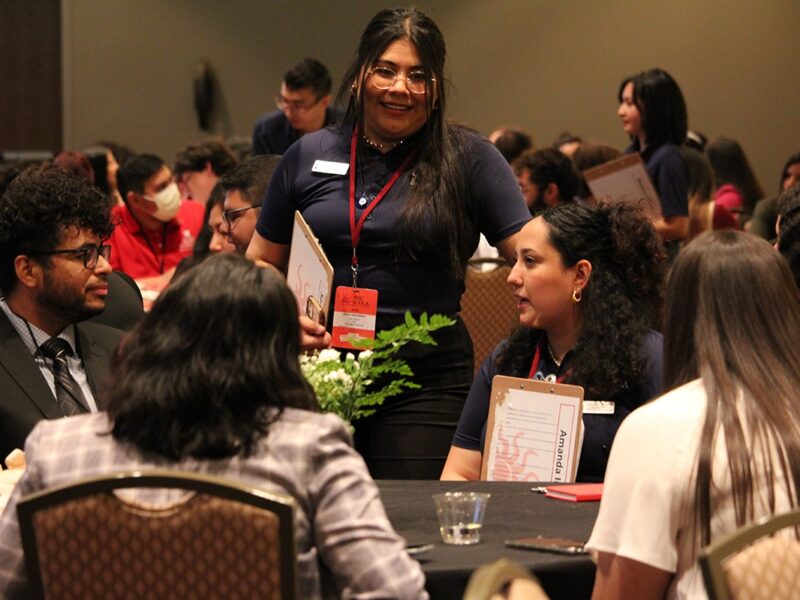Growth Within Aggieland
More than three decades. The majority of the student population hasn’t even been alive for that long, much less planning life that far in advance. Most people want something from life. On the other hand, the “what” part of that equation is a whole different can of worms. For those of you who wake up in the morning and wonder if you should change your major (for the fourth time), or can’t decide between traveling the world or attending MATH 141, there is hope for you yet. David Woodcock and Arnold Krammer are two professors at Texas A&M who began their careers while unsure of which path to take. Yet through their experiences and their 30-plus-years at Texas A&M University, not only have they taught many students, they’ve grown up and found their calling with A&M.
Woodcock of the architecture department has taught at Texas A&M University for 44 years with 14 different presidents including General James Earl Rudder. Woodcock came to Texas A&M in 1962 after graduating from the University of Manchester with a professional degree in architecture two years previous. Wanting to see the world but lacking a certain amount of funds needed, Woodcock applied and received a Fulbright Scholarship allowing travel and stay at Texas A&M for nine months.
“The idea of the Fulbright Program is a scholarly exchange, you visit another country and share your experiences and knowledge with them and meanwhile, you get a better understanding of who they are so when you go back home,” Woodcock said.
During this time, Britain was still recovering from World War II and had bread rationing in until 1952. In choosing a destination, Woodcock came to America looking for new experiences and adventures across the Atlantic he had heard so much about during the War. He also knew of the Brazos Valley because his grandfather was a cotton buyer for a spinning company, and bought many shipments of cotton from right here in College Station.
“When we opened our architecture magazines to read about what was happening in the world we saw that America had recovered brilliantly from the war,” Woodcock said. “I decided I really wanted to find out what it looked like.”
The journey to get to Texas A&M was quite different than today. The trip took two weeks and consisted of a freighter from Liverpool to Boston, a train to New York, a train to Chicago, a train to Houston, and a Grey Hound bus to College Station. When Woodcock finally arrived Texas A&M for the first time, he experienced the effects of culture shock and not to mention a heat wave as it was August.
“For the most part the students I was working for were in uniform, and I was quite unaccustomed to that,” Woodcock said. “It was very strange.”
After his Fulbright Scholarship term, Woodcock returned to England and began teaching at Canterbury University. A few years later, the first dean of the Architecture College of Texas A&M visited Woodcock in England and gave him a job offer. In the end, Woodcock packed up once again and, along with his wife, traveled back to College Station.
“By then, it had become Texas A&M University. Earl Rudder had died sadly, and far too young,” Woodcock said. “We had a new image of what Texas A&M was becoming; women had been allowed to enroll and enrollment of the Corps of Cadets was optional – two decisions that I think were brilliant.”
It is evident how professors like Woodcock care for the students. Jolynn Easter, a junior business management major, said she is relieved when she encounters a professor such as Woodcock who has been at Texas A&M for an extended period of time. Like many students at A&M, Easter juggles school and multiple jobs; she is an Advancement Via Individual Determination (AVID) tutor at Stephen F. Austin Middle School in Bryan, Texas and is the assistant coordinator for Aggie Athletics 12th Man Rewards Program.
Through the day, she is comforted by the fact that the goal of professors like Woodcock is to help shape the students’ future, not make their lives more complicated.
“The main advantage to having a professor who has been here for so long is that they understand what being an Aggie is all about,” Easter said.
“It’s more than just getting an education. It’s about making a difference and caring about people.”
In addition to Woodcock, another professor devoted to the students at Texas A&M is Krammer, professor of history, who has been at A&M 37 years.
“I’ve been teaching here longer than some of my students have been alive,” Krammer said. “I’m getting people in my classes telling me that their parents also had me as a professor when they came to A&M.”
Hailing from Chicago, Krammer began his collegiate career in chemistry at the University of Wisconsin, only to end up a devoted history aficionado and tenured professor of Nazi and German history.
“I love to teach,” Krammer said. “My wife says that if I didn’t have a classroom, I’d probably teach door to door saying ‘Hello! Have you heard about World War I?’”
The passion for the past has been a fundamentaljoy of Professor Krammer as his parents came to America as Hungarian immigrants. This sparked his interest for the time period and culture of World War I and II in Europe.
“I heard all about the War and the Nazis growing up; I got it with my mothers milk,” Krammer said.
Through the years, Krammer is always gathering new bits of information he wouldn’t be able to gain elsewhere such as discovering a German Prisoners of War Camp while passing through Hearne, Texas. He has seen A&M through and through and loves seeing students new and old.
“In many ways, A&M and I grew up together,” he said.
Knowing and growing with A&M is one of the parts of a professor’s duty. Freshman Taylor Pharis came to A&M from Abeline, Texas, and the professors she has encountered thus far helped ease her fears of the college transition.
“The professors who’ve been here for so long are more connected with the school,” Pharis said. “Therefore they’re more connected with us, the students.”
This article by Sarah Smith originally appeared in The Battalion.





